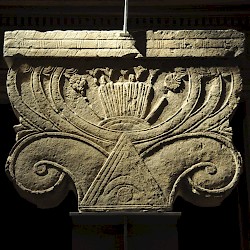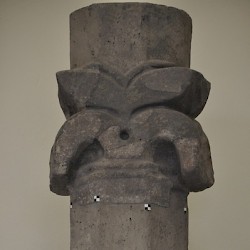Building Orders and Capitals
Building order: a style of (Graeco-Roman) building design.

Although there used to be complex rules to determine the proportions of columns and entire buildings, the ancient building orders are easy to recognize by just looking at the capitals. According to the Roman architect Vitruvius, the Greeks and Romans generally recognized three styles of building (Doric, Ionic, Corinthian),note which received their classical shape in the fifth and fourth centuries BCE. Of course, they were all painted, although the colors must have faded swiftly, and few people will have seen the ancient monuments in their full polychrome splendor.
Here are the three basic types:
- Doric. The simplest type: essentially, a square plate (abacus) on top of a round plate. The photo below shows a classical Doric capital from the temple of Zeus in Cyrene in Libya.
- Ionic. More complex: scroll-like ornaments on the sides ("volutes") have been added. The photo belows show a classic Ionic capital from Apamea in Syria.
- Corinthian. Even more complex, with acanthus leaves. The photo below shows a Corinthian capital from Epidauros that was carefully buried and may have been the archetype of all later Corinthian capitals.
The Aeolic type had some popularity in the Archaic Age but was forgotten in Greece, although it remained in use on Cyprus and in the Near East.
 Cyrene, Temple of Zeus, Doric capital |
 Apamea, Ionic capital |
 Epidaurus, Corinthian capital |
 Aeolian capital (Idalion) |
However, there were more types, sometimes created by nations and cities that wanted to stress their non-Greek identity and cultural independence. Examples are:
- Pergamene capital, which may have been inspired by the Egyptian palm columns. The photo below is from the temple of Athena in Pergamon.
- Nabataean capital with small triangles. The photo below is from an honorific arch in from Bosra in Syria.
 Oropos, Aeolian-Ionic capital |
 Pergamene capital |
 Bosra, Nabataean Arch, capital |
 The Asclepium of Balagrae, silphium-shaped capital |

I must be noted that the three classical building orders - Doric, Ionic, Corinthian - were always common, but that Greek and Roman sculptors were no slaves of these designs. The Aeolian-Ionic capital from Oropos above shows that in about 600 BCE, the difference between Ionian and Aeolian styles was not as well-defined as it was later supposed to be. The capital from Libyan Balagrae, decorated with silphium, is a local variant of the Ionic capital.
The Romans frequently combined Ionic volutes with Corinthian acanthus leaves, an imperial style that has since the Renaissance been called a "composite order". This name has been losely applied to many other variants, usually derivates from the classical Corinthian order. A remarkable innovation is the "Theodosian capital", which has an extremely deep relief. In the end, sculptors were completely free, which resulted in the splendid, unique capitals of, for example, the Medieval cloisters and churches.
Finally, for comparison, some capitals that were not inspired by the classical Graeco-Roman building orders.
 Aššur, Assyrian capital |
 Luxor, Temple, Capitals of columns |
 Knossos, Palace, Columns |
 Lion-shaped Indian capital from the age of Ashoka |







